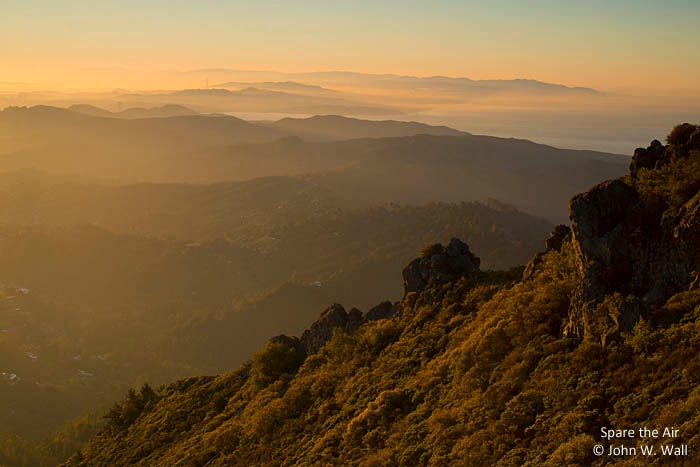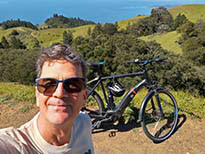* * *
I made a detour on the way to Redwood Creek to photograph the sunrise from the tourist turn-out, just downhill from where the guy who sells nuts out of the back of his pick-up truck can be found on many weekends. There are usually numerous cars pulled out in the vicinity because the view is so nice, and it's where you first get a high viewpoint after driving up from Tam Junction. Anyway, I shot numerous frames at various f-stops, both vertically and horizontally, and the lens flare problem seems to be adequately resolved. Looks like I just needed to clean a bit of schmutz off my lens. Let that be a lesson to me: it's not always about sensor dust.

I've been wanting to photograph Redwood Creek from Muir Beach to Muir Woods, sort of following along the winter-run salmon route, but there isn't enough water for a salmon run, and Muir Beach has been closed for months (and the re-opening date, currently December 28, keeps getting bumped further out). I made my first stop just downstream of Muir Woods, at this bridge where the graffiti has been carved out of the mossy abutment.
The scenery along Redwood Creek is so different from anywhere else on Mt. Tam. Down here it's almost flat. What little water remains in the creek is barely moving. In a normal rain year, the creek moves along briskly, and the salmon really do swim upstream to spawn. One year I watched salmon leaping from the creek up and into a metal culvert, out the other end, and onward to the redds at the far end of Muir Woods.
It was fun to quietly amble around in the creek bed to look for compositions in the chaotic tangle of woodland.
I almost forgot to mention, the main reason I came back up to the mountain so soon was to set the camera trap in a new location. After I got the SD card home yesterday and saw what I'd gotten, I didn't want to leave the camera in that spot for another week. I found what I hope will be a much more interesting spot.
It was chilly down there in the bottomland.
The tree species of the day: Red Alder.
I've always loved the alders along Redwood Creek, but I haven't photographed them more than a couple of times.
This morning I made up for lost time.
Alders are able to fix atmospheric nitrogen, enriching the soil.
I was impressed by all the lichens covering many of their trunks.
As the sun rose over the southern ridges, gusts of warm air blew away some of the cold.
A little bit fall color was still in evidence, thanks to creek dogwood.
I wish I'd spent more time photographing around the north-side reservoirs this fall, and also down here along the creek. There's lots more color to be had than I recalled.
I sort of bunny-hopped my way down the creek. I'd drive to a turn-out, investigate the creek, then head back to the Jeep and move downstream to the next spot.
I'm sure alders aren't for everyone, but I think they're a fine-looking tree, even without their leaves.
Here's a bay laurel with lots of old man's beard lichen hanging from its branches.
Back down to the creek, with more alder along the banks, and nothing but alder leaves floating downstream.
Would you believe it?! I saw these tiny white things down by my feet and thought they were litter, then maybe some kind of moth, then, after squinting real hard, I finally saw they were wildflowers. I'd never photographed spiderwort on Mt. Tam before. I was familiar with the genus from learning it in Florida when I was staying with my parents out near the Merritt Island National Wildlife Refuge for a few months many years ago. Anyway, this species is native to South America and is an escaped ornamental here. Its other common name is "Wandering Jew," a name with an interesting history. I liked this writer's take on it:
"Any botanist will tell you that the 'Wandering
Jew' is a unique species of plant which - when given minimal sustenance -
will nevertheless spread and grow. Similarly, if you cut out its roots and
plant it in other soil, it will regenerate itself and start anew.
"This plant's nomenclature is, of course, a comment on the
Jewish People's ability to adapt to varied environments and conditions. 'Wandering' is what Jewish history has been all about. The Patriarchs
and Matriarchs were nomads. The Jewish nation itself was forged in Egypt and
while wandering through the Sinai desert - the only nation ever to establish
its identity while wandering outside its homeland. And for the past 2000 years
we have been wandering the world."

I wanted to hike up into that fern-filled hillside, but there was no immediately apparent way to get there -- no deer trail or gently sloping section of embankment. I know I've been up in there before, many years ago, but I didn't have the will to do the scrambling this morning. I was interested in some blue ribbon markers dangling from branches up in there. There are lots of ribbon markers along the creek because it's a rare salmon stream that runs through a state park and connects two national park units. I've seen biologists wading through the stream to count salmon in other years and I figure there are various studies going on all the time. But as to what those ribbons higher up the slope are about, I have only curiosity.

I walked right by this buck deer carcass, first noticing that the area was quite trampled and apparently rooted up. As I reached around for my eyeglasses to see if the tracks in the sand belonged to feral pigs, I spotted the buck's remains. I wouldn't be surprised if it's been there no more than a week. A windfall feast like that gets devoured quickly. Not only were all the meat and flesh gone, but the legs as well. It's always a powerful and contemplative moment to discover an animal's remains, even more so when the animal is a full-grown buck.
* * *























































